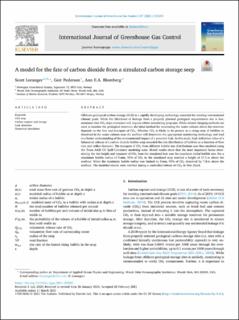| dc.contributor.author | Loranger, Scott | |
| dc.contributor.author | Pedersen, Geir | |
| dc.contributor.author | Blomberg, Ann E.A. | |
| dc.date.accessioned | 2021-08-18T09:22:44Z | |
| dc.date.available | 2021-08-18T09:22:44Z | |
| dc.date.created | 2021-07-29T23:51:20Z | |
| dc.date.issued | 2021 | |
| dc.identifier.citation | International Journal of Greenhouse Gas Control. 2021, 107 1-8. | en_US |
| dc.identifier.issn | 1750-5836 | |
| dc.identifier.uri | https://hdl.handle.net/11250/2770047 | |
| dc.description.abstract | Offshore geological carbon storage (GCS) is a rapidly developing technology essential for meeting international climate goals. While the likelihood of leakage from a properly planned geological sequestration site is low, assurance that CO stays contained will require robust monitoring programs. While seismic imaging methods are used to monitor the geological reservoir, the ideal method for monitoring the water column above the reservoir depends on the fate and transport of CO. Whether CO is likely to be present as a rising seep of bubbles or dissolved in the water column near the seafloor will determine the appropriate monitoring technology and lead to a better understanding of the environmental impact of a potential leak. In this study, high definition video of a laboratory release of a carbon dioxide bubble seep recorded the size distribution of bubbles as a function of flow rate and orifice diameter. The transport of CO from different bubble size distributions was then modeled using the Texas A&M Oil Spill Calculator modeling suite. Model results show that the most important factor determining the rise height and transport of CO from the simulated leak was the maximum initial bubble size. For a maximum bubble radius of 5 mm, 95% of CO in the simulated seep reached a height of 17.1 m above the seafloor. When the maximum bubble radius was limited to 3 mm, 95% of CO dissolved by 7.8 m above the seafloor. The modeled results were verified during a controlled release of CO in Oslo Fjord. | en_US |
| dc.language.iso | eng | en_US |
| dc.title | A model for the fate of carbon dioxide from a simulated carbon storage seep | en_US |
| dc.type | Peer reviewed | en_US |
| dc.type | Journal article | en_US |
| dc.description.version | publishedVersion | en_US |
| dc.source.pagenumber | 1-8 | en_US |
| dc.source.volume | 107 | en_US |
| dc.source.journal | International Journal of Greenhouse Gas Control | en_US |
| dc.identifier.doi | 10.1016/j.ijggc.2021.103293 | |
| dc.identifier.cristin | 1923111 | |
| cristin.ispublished | true | |
| cristin.fulltext | original | |
| cristin.qualitycode | 1 | |
